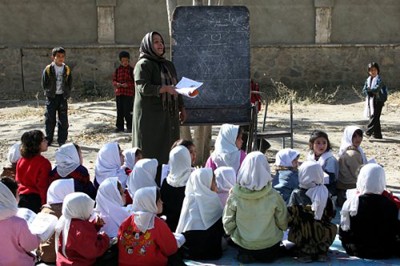Razia, aged 10, cannot go to school because doing so is deemed too risky for girls in the southern province of Kandahar, and because her father believes only boys should attend school.

Rukhsana School in Kabul. According to the UN Educational, Scientific and Cultural Organization (UNESCO), literacy rates for Afghan females aged 15-24 in comparison to their male peers were on average about 10 percent lower. (Photo: Fardin Waezi-UNAMA)
“My father says schools are not for girls and that girls should work at home,” she told IRIN in Kandahar, adding that she had always wanted to go to school and become a doctor.
Her father, Abdul Rahim, said: “I am not the only father banning my daughter from school… No man wants his daughter or sister to be attacked and disgraced by the Taliban for schooling,” Rahim said.
His fears are not baseless: In November 2008, unidentified attackers sprayed acid over a dozen of female students and teachers in Kandahar Province in what was seen as a move to discourage girls’ education.
Conservative customs, poverty, lack of educational facilities and a strong culture of gender discrimination have deprived over five million school-age children (over three million of them girls) of an education, according to aid agencies and the Ministry of Education (MoE). That is roughly one third of Afghanistan’s under 18 population of about 14.5 million in 2007, according to the UN Children’s Fund.
Most illiterate children are girls. According to the UN Educational, Scientific and Cultural Organization (UNESCO), literacy rates for Afghan females aged 15-24 in comparison to their male peers were on average about 10 percent lower
Lack of schools
Afghanistan has some 12,000 public schools (primary and secondary). Roughly half of them do not have a building: students assemble in tents and/or in the open, say officials.
Insurgents have torched hundreds of schools and killed dozens of teachers and students over the past four years in a country which desperately needs more schools and teachers.
About 700 schools were reportedly closed because of insecurity and attacks in 2008, though some have been re-opened over the past few months, the MoE has said.
Over six million students, about 34 percent of them female, were enrolled in public schools in 2009 and the government has vowed to double that number by 2020.
Afghanistan is one of the least literate countries in the world. Only 18 percent of women and 50 percent of men are able to read and write, according to UNESCO.



